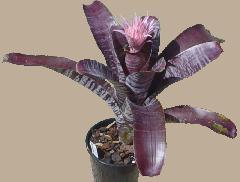
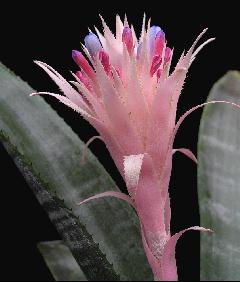
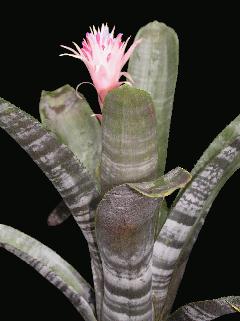
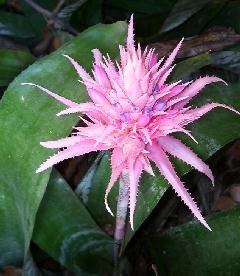
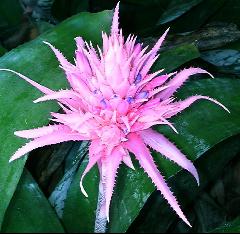
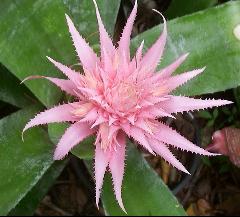
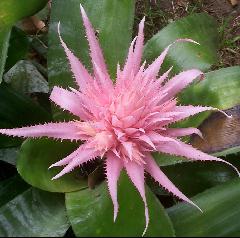
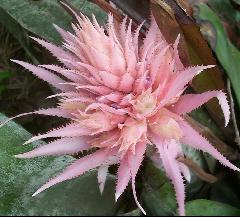
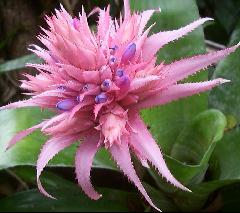
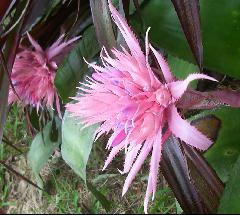
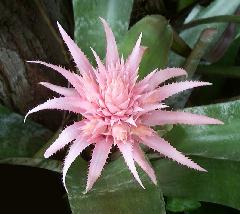
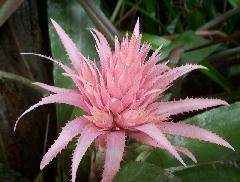
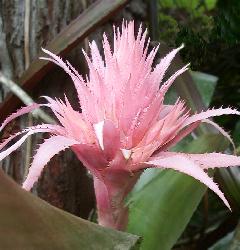
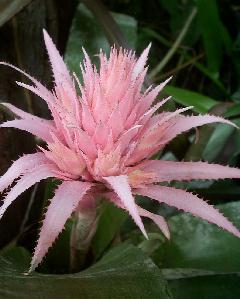
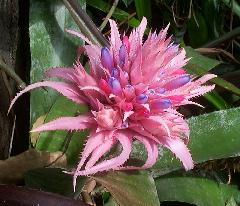
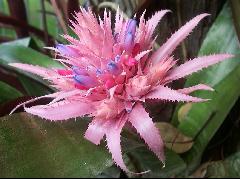
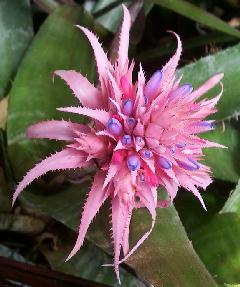
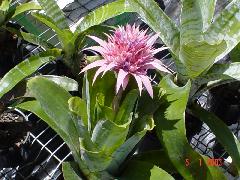
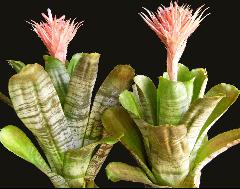
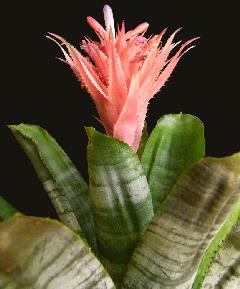
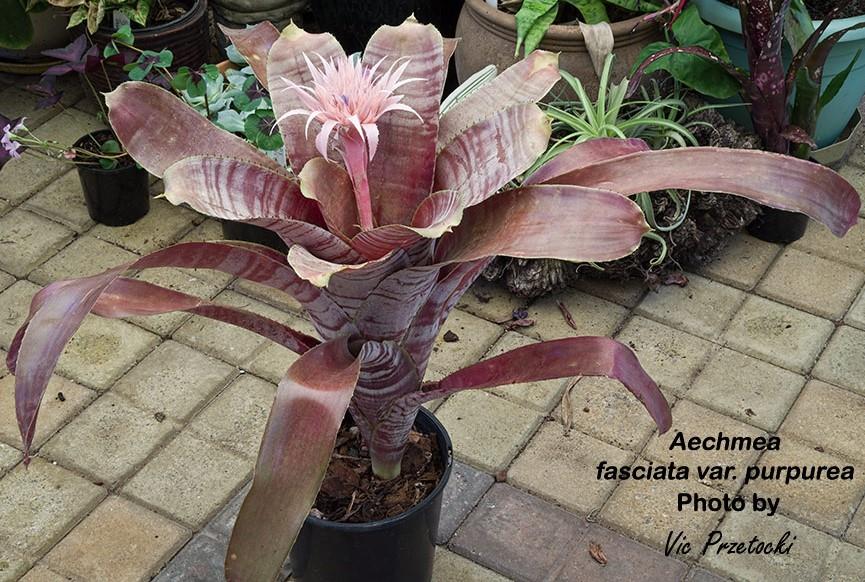
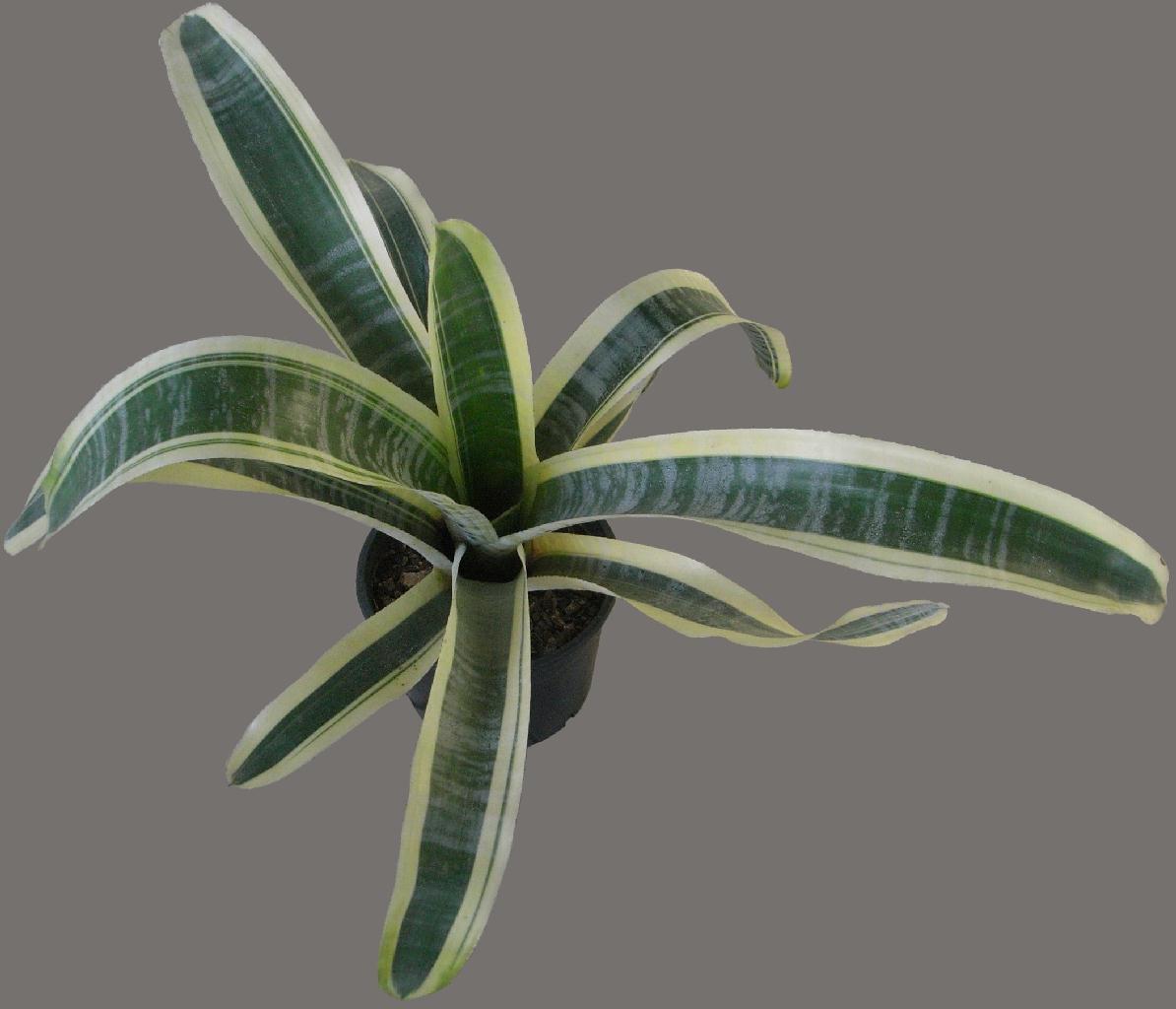
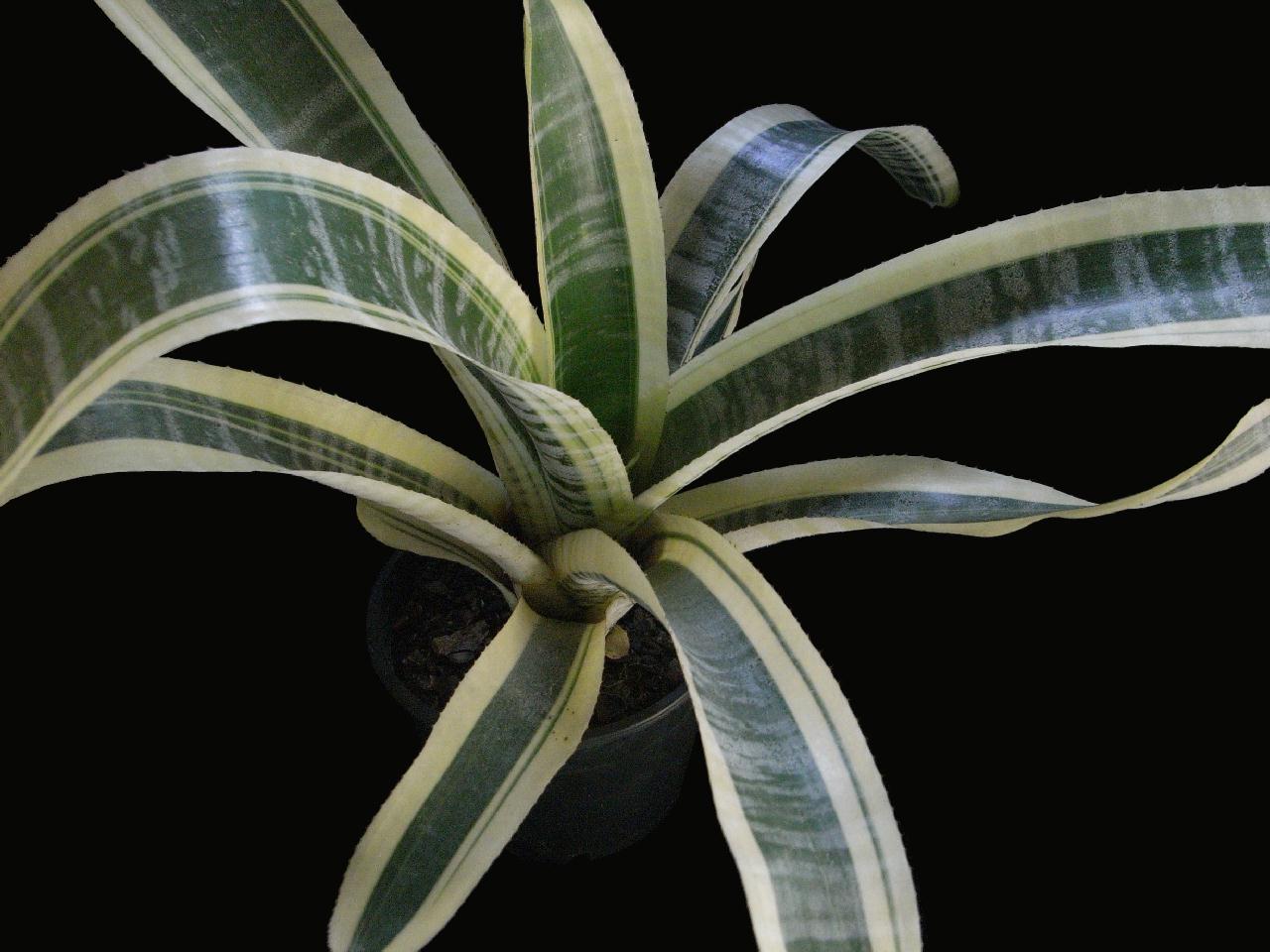
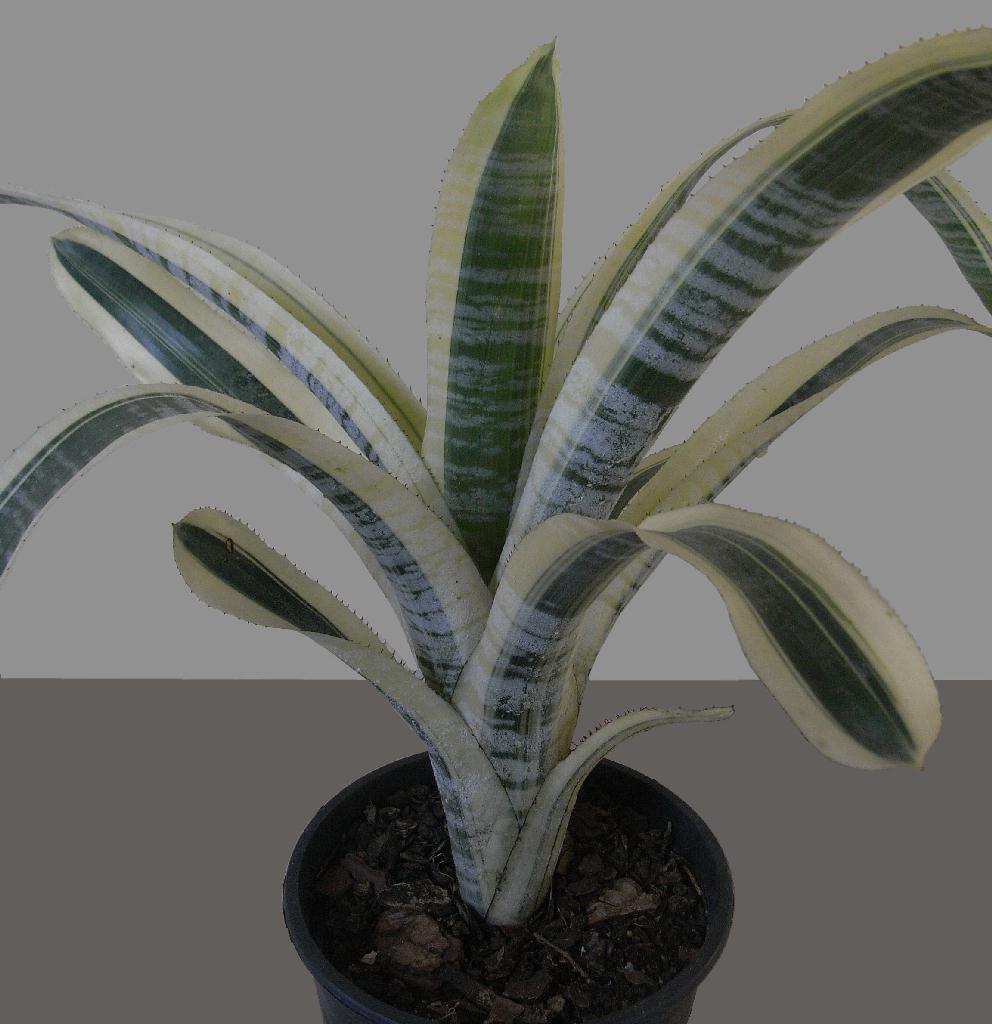
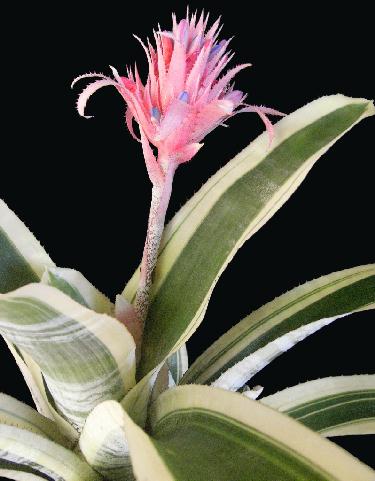
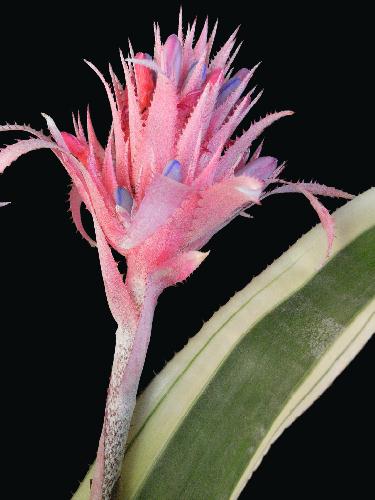
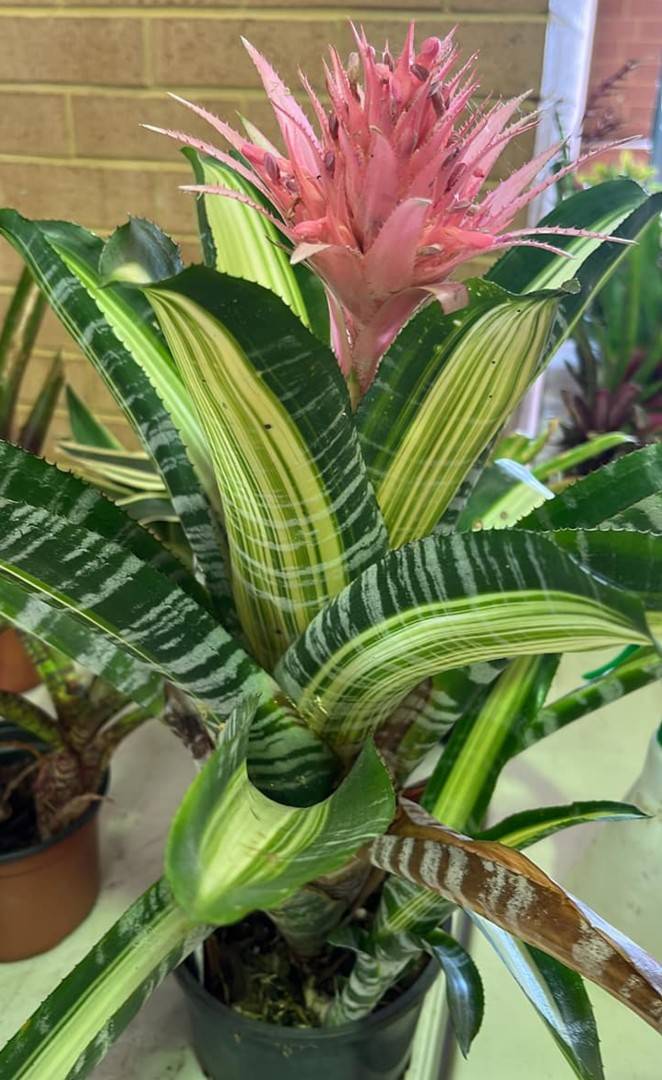

Aechmea fasciata var fasciata
Billbergia fasciata Lindley, Bot. Reg. 13: pl. 1130. 1828.
Hohenbergia fasciata (Lindley) Schultes filius in Roemer & Schultes, Syst. 7(2): 1253. 1830.
Billbergia rhodocyanea Lemaire, Fl. Serres 3: pl. 207. 1847. Type. Van Houtte Hortus ex Van der Maelen Hortus (no known specimen, so the original plate).
Hoplophytum fasciatum (Lindley) Beer, Bromel. 129. 1856.
Billbergia glaziovii Regel, Gartenflora 34: 260, pl. 1203. 1885. Type. Glaziou in Petrograd Hortus s n (holotype, LE n v).
Aechmea leopoldii hortus ex Baker, Handb. Bromel. 58. 1889; nomen.
Aechmea hamata Mez, Mart. Fl. Bras. 3(3): 347. 1892. Type. Berlin Hortus s n (holotype. B: photo F 11314).
Aechmea rhodocyanea Wawra ex Mez, DC. Monogr. Phan. 9: 255. 1896; nomen.
Quesnelia rhodocyanea Wawra ex Mez, DC. Monogr. Phan. 9: 255. 1896; nomen.
Leaves green.
Type. Original description and plate.
Distribution. Epiphytic in forest, 700-1300 m alt, Rio de Janeiro and (Guanabara), Brazil.
BRAZIL. Rio de Janeiro: Organ Mouncains, 1838-39, Wilkes Expedition s n (US); Feb 1927, Luetzelburg 20116 (M); Teresopolis, Jan 1897, Ule 4137 in part (CORD, R); 14 Mar 1924, Bailey 1295 (BH); Nov 1929, Brade s n (R); Jan 1943, Veloso s n (R); 9 Dec 1948, Duarte & Pereira s n (RB); 14 May 1956, Abendroth 1 (US); Alto da Serra. to Meio da Serra, 22 Dec 1928, L. B. Smith 1548 (GH, S); Rio Paquequer, Serra dos Orgaos, 26 Jul 1940, Brade 16484 (RB); Petropolis, 10 Apr 1952, L. B. Smith & Mus R 6459 (R, US); Teodoro de Oliveira to Nova Friburgo, 20 Apr 1952, L. B. Smith & Mus R 7112 (R, US); Inoa, 23 Jul 1961, Gomes, Emygdio & Burle Marx 1219 (RB). (Guanabara): Rio de Janeiro, 1838-39, Wilkes Expedition s n (GH); Gaudichaud 123 (P); Andarai Grande, Glaziou 11686 (K, P); Engenho Novo, 18 May 18-9, Glaziou 11677 (P); Quinta da Boa Vista, cultivated (?), 16409 (P); Sao Cristovao, cultivated, 1897, Ule s n (R); Corcovado. 1845-47, Didrichsen 4138 (C); 28 Nov 1928, L. B. Smith & Vieira 1384 (B, GH); 1 Dec 1928, L. B. Smith 1396 (GH); 23 May 1941, J. G. Kuhlmann 6152 (RB, US); Realengo, Sep 1933, Viana Freire 400 (R); Gavea, Reitz 4474 (HBR).
Aechmea fasciata var purpurea (Guillon) Mez, Pflanzenreich IV. 32: 152. 1934.
Billbergia rhodocyanea var. purpurea Guillon, Rev. Hortic. 55: 453. 1883.
Leaves red-purple.
Type, Cherbourg Hortus s n (evidently no specimen preserved).
Distribution. Rio de Janeiro State, Brazil.
BRAZIL. Rio de Janeiro: Teresopolis, 20 Aug 1940, Foster 977 (GH); 8 Jun 1956, Abendroth 1a (US)
Aechmea fasciata var. pruinosa Reitz, Sellowia 33: 55. 1981
Leaves, scape bracts, and flowers white farinose; densely covered in scales forming a white skin
Type Brasil, Santa Catarina: Ipanema plant cultivated in the State of Rio de Janeiro, collected Adda Abendroth s.n. 14 Feb. 1981. Holotype HBR
Aechmea fasciata var. flavi-vittata Reitz, Sellowia 33:55. 1981. As at June 2017 treated as a Cultivar ‘Flavi-vittata’ see BCR
Leaves with longitudinal lines alternately green and yellow
Type Brasil, Santa Catarina: Brusque, cultivated in the State of Rio de Janeiro, leg J Pehnk s. n. (15.2. 1981), Holotype HBR
Notes from Adda Abendroth to Australia in 1968
Aechmea fasciata is a common plant these days but only because of careful selection and breeding in Europe over many many years. We still grow the 'small' form of Aechmea fasciata var. purpurea as mentioned in the following paragraph. I quote from a letter from Adda on June 17th 1968.
"Years ago Dr. Oeser sent me some A. fasciata seed from Germany. Several plants raised from it flowered and put their wild sisters to shame. Mature plants are about twice as big, clad in a real snow-dress in winter and have a larger and richer spike and more simultaneous flowers. The flower bracts are slightly curled. It is our light-green variety plus a successful beauty treatment. Our light-green form is faithful as to shape and size and habits. It blooms in early Spring, or a little later, sparingly. The plants grow on tree trunks or branches in virgin forest. The colonies are not large, to 3-5 shoots.
Another variety has dark green leaves, sometimes tinged with red. Size about the same as the light-green form but not so even, colonies somewhat larger. Habitat the same.
The third form appears growing on nearly naked branches of old trees, mostly single rosettes 20-30cm in diameter. The colour is rosy, shape nice and even. This form, when planted in shade (tied to a branch or a trunk) has darker and longer leaves. The rosy pink seems to develop only high up in the trees, exposed to sun and wind.
The fourth is the variety purpurea which has wine-red leaves. Habit like the dark-green form. In deep shade the leaves get very long and fall over. The red is almost black making a striking contrast with the white bands. This is more common than the total of the other three."
CHAVE PARA AS VARIEDADES
1 - Folhas igualmente coloridas (concolores) => 2
1 - Folhas com Iistas longitudinais alternantes verdes e amarelas => 6d. var. flavi-vittata
2 - Folhas verdes com faixas brancas transversais => 6a. var. fasciata
2 - Folhas nao verdes. => 3
3 - Folhas branco-farinosas. => 6b. var. pruinosa
3 - Foihas vermelho-purpureas. => 6c. var. purpurea
6A. AECHMEA FASCIATA (LINDLEY) BAKER VAR. FASCIATA
GRAVATA
Baker, Jour. Bot. London 17: 231. 1879; L.B. Smith & R.J.Downs, Flora Neotropica 14 (3): 1888, fig. 644 C. 1979.
Billbergia fasciata Lindley, Bot. Reg. 13: tab. 1130. 1828.
Hohenbergia fasciata (Lindley) Schultes filius in Roemer & Schuttes, Syst. 7 (2): 1253. 1830.
BilIbergia rhodocyanea Lemaire, Fl. Serres 3: tab. 207. 1857.
Hoplophytum fasciatum (Lindley) Beer, Bromel. 129. 1856.
Billbergia gIaziovii Regel, Gartenflora 34: 260, tab. 1203. 1885.
Aechmea leopoldii hortus ex Baker, Handb. Bromel. 58. 1889: nomen.
Aechmea hamata Mez, Mart. Fl. Bras. 3 (3): 347. 1892.
Aechmea rhodocyanea Wawra ex Mez, DC. Monogr. Phan. 9: 255. 1896, Nomen.
Quesnelia rhodocyanea Wawra ex Mez, DC. Monogr. Phan. 9: 255. 1896; nomen.
PLANTA propagando-se por rizomas a partir da base e da inflorescencia. FOLHAS 10-20 em roseta cilindrica ou levemente funiliforme, 3-10 dm de comprimento, excedendo a infloresccncia, cobertas de ambos os lados com escamas palidas apressas, com faixas pelidas por baixo; BAINHAS grandes, mas somente pouco mais largas que as laminas, elipticas, inteiras, as vezes purpureo-coloridas; LAMINAS liguladas, largamente agudas ou subarredondadas e apiculadas, 5-6 cm de largura, laxamente serruladas com espinhos castanhos de 1.5-5mm. de comprimento, verde-escuras, palidamente lepidotas e mais ou menos bandadas por baixo. ESCAPO ereto, tenro, inicialmente densamente floculoso; bracteas escapais lanccoladas, acuminadas, pungentes, densamente serreadas, roseas, as inferiores laxas e eretas, as superiores agrupadas sob a inflorescencia.
INFLORESCENCIA simples ou com poucos ramos na base, densamente piramidal, 7-8cm de comprimento, branco-floculosas na antese; bracteas primarias semelhantes as bracteas escapais, maiores que os ramos; espigas densamente pouco floridas. BRACTEAS FLORAIS lanceoladas ou ovadas, acurninadas, maiores que os sepalos, roseas, fortemente serruladas, as margens curtamente adnatas a raquis e formando um bolsa debaixo da flor; FLORES polisticas, sesseis, 30-35mm de comprimento. SEPALOS assimetricos, mucronulados ou agudos, 10-12mm de comprimento, 1/2 concrescidos, carinados, esparsamente branco-tomentosos; PETALOS ligulados, 25-30mm de comprimento, azuis, purpureos ou vermelhos quando secos. apresentando 2 ligulas fimbriadas na base; ESTAMES inclusos. filamentos da II serie altamente concrescidos aos petalos; OVARIO elipsoide, tubo epigino curto; placentas apicais, ovulos longo-caudados.
Tipo - Descricao original e ilustracao.
Nomes vulgares - Gravata, monjola, bromelia.
Observacoes ecologicas - Planta propagando-se por rizomas a partir da base e da inflorescencia, folhas de 10 a 20 em roseta cilindrica ou levemente funiliforme, medem de 30 a 100 cm de comprimento. excedendo a inflorescencia, cobertas de ambos os lados com escamas palidas apressas: com faixas transversais palidas por baixo que caracterizam sensivelmente a especie, inflorescencia simples ou com poucos ramos na base, densamente piramidal de 7 a 8 cm de compr., bracteas escapais e florais lindamente roseas e visivelmente contrastantes com flores azuis; caracteristica e exclusiva da Flioresta Pluvial Tropical Atlantica do Rio de Janeiro e Espirito Santo, nao chegando ate o Estado de Santa Catarina em estado nativo.
Especie possivelmente de luz difusa e epifita; desenvolve-se no interior das florestas das encostas e de altitude da Serra do Mar e suas ramificacoes, situadas em 700 a 1300 metros sobre o nivel do mar.
Material estudado _ RIO DE JANEIRO: Gavea, R. Rcitz 4474 (03.03.1952), HBR, Santa Maria Madalena, 700 m, A. Seidel 36 (22.04.1954), HBR. Teresopolis, perto da cidade, L. Seidel 222 (- 06.1961), HBR. Pico da Tijuca, epifito da mata, 800 m, R. Reitz 7621 (21.05.1974), HBR. Serra da Pedra Branca, epifito da mata, 200m, R. Reitz 7690 (22.08.1974), HBR, frequente.
ESPIRITO SANTO: Domingos Martins, epiflta da floresta, R. Reitz 7?838
(19.04.1975), HBR
SANTA CATARINA: ITAPEMA: cultivada na cidade, R. Reitz 7974 (14.02.1981 ).
Area de dispersao - BRASIL: Rio de Janeiro e Espirito Santo.
Utilidade - Bromelia de enorme valor ornamental, sendo na Europa uma das especies mais usadas em decoracoes de vitrines de lojas comerciais.
6d. AECHMEA FASCIATA VAR. PRUINOSA * Reitz
(*Do lat. pruinosa (de pruina, geada, neve) devido a cor brancacenta, como neve, de suas folhas e bracteas escapais e florais.)
GRAVATA
Reitz, Sellowia 33: 55. 1981.
FOLHAS branco-farinosas; densamente escamadas formando uma pele branca.
Tipo - Brasil, Santa Catarina: Itapema, planta cultivaata procedente do Estado do Rio de Janeiro, coletada por Adda Abendroth s. nr. em 14 de fevereiro de 1981; holotipo HBR.
Nomes vulgares - Gravata, monjola, bromelia.
Dados fenologicos - Floresce em janeiro.
Observacoes ecologicas - Planta que se distingue da variedade tipica pelas folhas branco-farinosas, densamente escamadas, formando uma pelicula branca; caracteristica e exclusiva da Floresta Pluvial Tropical Atlantica do sudeste do Brasil, onde possivelmente e muito rara,, nao chegando em estado nativo ate o Estado de Santa Catarina.
Variedade, ate o momento, apenas conhecida pelo tipo, proveniente do interior das florestas do Estado do Rio de Janeiro e por isso possivelmente muito rara; coletada, em estado de cultivo, em Itapema, Santa Catarina por R. Reitz.
Material estudado - SANTA CATARINA: ITAPEMA: cultivada na casa do autor, Adda Abendroth s. nr, (14.02.1981), HBR,; o clone continua sendo cultivado pelo autor e e distribuido a amigos bromelicultores. Foi-me presenteado por Adda Abendroth, quando como diretor do Jardim Botanico do Rio de Janeiro, a visitei na Ilha ale Paqueta onde morava. A planta procede de Teresopolis, Estado do Rio de Janeiro.
Area de dispersao - RIO DE JANEIRO: municipio de Teresopolis.
Utilidade - Planta muito decorativa pela cor nevada de suas largas folhas.
6c. AECHMEA FASCIATA var. PURPUREA* (Guillon) Mez
(* Do lat. purpurea (purpurea) devido e cor vermelho-purpurea de suas folhas.
GRAVATA
Mez, Pflanzenreich IV. 32: 152, 1934.
Bilbergia rhodocyanea var. purpurea Guillon, Rev. Hortic. 55: 453. 1883.
FOLHAS vermelho-purpureas.
Tipo - Cherbourg Hortus s. nr. (evidentemente no foi preservado nenhum especime),
Nomes vulgares - Gravata, monjola, bromelia.
Dados fenologicos - Floresce em janeiro.
Material estudado - RIO DE JANEIRO: TERESOPOLIS: perto da cidade, L. Seidel 221 (-.06.1961), HBR.
SANTA CATARINA: ITAPEMA: cultlvade, R,. Reitz 7975 (14.02.1981), HBR, procedente de Teresopolis, Estado do Rio de Janeiro.
Area de dispersao - RIO DE JANEIRO: no municipio de Teresopolis.
Utilidade - Planta decorativa.
6d. AECHMEA FASCIATA var. FLAVI-VITTATA ** Reitz
(** lat. flavi-vittata (amarelo-listada), devldo as folhas verdes com listas amarelas.)
GRAVATA
Est. 9 Reitz, Sellowia 331 55. 1981.
FOLHAS com listas longitudinais alternantes yerdes e amarelas.
Tipo - Brasil, Santa Catarina: Brusque, cultivada procedente alo Estado do Rio de Janeiro, J. Pehnk s. nr. (14.02.1981), holotipo,
Nomes vulgares - Gravata, monjola, bromelia.
Dados fenologicos - Floresce em janeiro e fevereiro.
Observacoes ecologicas - Planta que se distingue da variedade tipica e da variedad pruinosa pelas folhas com listas longitudinais alternantes verdes e amarelas; caracteristica e exclusiva da floresta pluvial tropical da Encosta Atlantica do sudeste do Brasil, onde possivelmente e muito rara, nao chegando em estado nativo ate o Estado de Santa Catarina.
Variedade, ate o momento, apenas conhecida pelo tipo, oriundo do interior das florestas do Estado do Rio de Janeiro; coletada, em estado de cultivo, em Brusque, Santa Catarina, por R. Reitz.
Material estudado - SANTA CATARINA: BRUSQUE: cultivada, procedente do Estado do Rio de Janeiro, J. Pehnk s. nr. (14.02.1981) holotipo; o clonotipo foi desenhado in vivo em cor por D. Fossari para esta obra e continua em cultivo por J. Pehnk.
Utilidade - Planta ornamental muito valorizada e cobicada pelos bromelicultores.
Area de dispersao - RIO DE JANEIRO: somente neste Estado.
KEY to the VARIETIES
Leaves equally coloured (concolorous) => 2
1-Leaves with longitudinal stripes alternating green and yellow => 6d. var. flavi-vittata
2-Leaves green with white transverse bands => 6a. var. fasciata
2-Leaves not green. => 3
3-Leaves white farinose. => 6b. var. pruinosa
3- Leaves red-purple. => 6c. var. purpurea
6A. AECHMEA FASCIATA (LINDLEY) BAKER VAR. FASCIATA
GRAVATA
Baker, Jour. Bot. London 17: 231. 1879; L.B. Smith & R.J.Downs, Flora Neotropica 14 (3): 1888, fig. 644 C. 1979.
Billbergia fasciata Lindley, Bot. Reg. 13: tab. 1130. 1828.
Hohenbergia fasciata (Lindley) Schultes filius in Roemer & Schuttes, Syst. 7 (2): 1253. 1830.
BilIbergia rhodocyanea Lemaire, Fl. Serres 3: tab. 207. 1857.
Hoplophytum fasciatum (Lindley) Beer, Bromel. 129. 1856.
Billbergia gIaziovii Regel, Gartenflora 34: 260, tab. 1203. 1885.
Aechmea leopoldii hortus ex Baker, Handb. Bromel. 58. 1889: nomen.
Aechmea hamata Mez, Mart. Fl. Bras. 3 (3): 347. 1892.
Aechmea rhodocyanea Wawra ex Mez, DC. Monogr. Phan. 9: 255. 1896, Nomen.
Quesnelia rhodocyanea Wawra ex Mez, DC. Monogr. Phan. 9: 255. 1896; nomen.
PLANT spreading by rhizomes from the base and the inflorescence.
LEAVES 10-20 in cylindrical or slightly funnelform rosette, 3-10 dm long, exceeding infloresccnce, covered on both sides with pale appressed scales, with pale bands underneath;
SHEATHS large, but only little wider that blade, elliptic, entire, sometimes purple colored;
BLADES ligulate, mostly sub-rounded and acute or apiculate, 5-6 cm broad, laxly serrulate with brown spines 1.5-5 mm. long, dark-green, lepidote and more or less dimly banded underneath.
SCAPE erect, tender, initially thick flocculose; scape bracts lanccolate, acuminate, pungent, densely serrated, pink, the lower ones lax and erect, the upper ones grouped under the inflorescence.
INFLORESCENCE simple or with few branches at the base, thick pyramidal, 7-8 cm long, white-flocculose at anthesis; primary bracts similar to scape bracts, larger than the branches; spikes densely few flowered.
FLORAL BRACTS lanceolate or ovate, acurninate, bigger than sepals, pink, strongly serrulate, margins adnate to stem and briefly forming a pouch under the flower;
FLOWERS polyscichous, sessile, 30-35 mm long.
SEPALS asymmetrical, mucronulate or acute, 10-12 mm long, 1/2 connate, carinate, sparsely hairy white;
PETALS ligulate, 25-30 mm long, blue, purple or red when dry. with 2 fimbriate ligules at the base;
STAMENS included. filaments of the II series highly concrescent to petals;
OVARY ellipsoid, epigynous tube short; placenta apical, ovules long-caudate.
Type -original description and illustration.
Common names - Gravata, monjola, bromelia.
Ecological observations - Plant spreading by rhizomes from the base and inflorescence, leaves 10-20 cm forming a cylindrical or slightly funnelform rosette, measuring from 30 to 100 cm long. exceeding the inflorescence, covered on both sides with pale appressed scales: with pale transverse bands underneath that characterize the species, inflorescence simple or with few branches at the base, dense pyramidal 7 to 8 cm long, scape and floral bracts beautifully pink, contrasting with blue flowers; characteristically and unique to Floresta Pluvial Tropical Atlantica in Rio de Janeiro and Espirito Santo, not coming to the State of Santa Catarina in their native state.
Species of diffused light and possibly epiphytic; grows inside the forests and slopes of the Serra do Mar and its branches, located at 700 to 1300 meters above sea level.
Material studied _ RIO DE JANEIRO: Gavea, R. Rcitz 4474 (03.03.1952), HBR, Santa Maria Madalena, 700 m, A. Seidel 36 (22.04.1954), HBR. Teresopolis, perto da cidade, L. Seidel 222 (- 06.1961), HBR. Pico da Tijuca, epifito da mata, 800 m, R. Reitz 7621 (21.05.1974), HBR. Serra da Pedra Branca, epifito da mata, 200m, R. Reitz 7690 (22.08.1974), HBR, frequente.
ESPIRITO SANTO: Domingos Martins, epifita da floresta, R. Reitz 7?838 (19.04.1975), HBR,
SANTA CATARINA: ITAPEMA: cultivada na cidade, R. Reitz 7974 (14.02.1981).
Area of dispersal - BRASIL: Rio de Janeiro and Espirito Santo.
Utility - Bromeliad of tremendous value, being one of the most commonly used species in Europe in decorations and commercial sales.
6 d. AECHMEA FASCIATA var. PRUINOSA* Reitz
(*from Latin pruinosa (pruinous, frosty, snowy) due to the whitish color, like snow, of its leaves and scape and floral bracts.)
GRAVATA
Reitz, Sellowia 33: 55. 1981.
LEAVES white-farinose; thick scales forming a white skin.
Type - Brasil, Santa Catarina: Itapema, planta cultivaata procedente do Estado do Rio de Janeiro, coletada por Adda Abendroth s. nr. em 14 de fevereiro de 1981; holotipo HBR.
Common names - Gravata, monjola, bromelia.
Phenological data – Flowers in January.
Ecological observation - plant that is distinguished from the typical variety by the leaves being white-farinose, dense scaled, forming a white film; characteristic and exclusive to Floresta Pluvial Tropical Atlantica in southeastern Brazil, where possibly very rare, not found in a native state in the State of Santa Catarina.
Variety, so far, is only known by the type, from the interior of the forests of the State of Rio de Janeiro and possibly very rare; collected in State of cultivation, in Itapema, Santa Catarina by R. Reitz.
Material studied - SANTA CATARINA: ITAPEMA: cultivada na casa do autor, Adda Abendroth s. nr, (14.02.1981), HBR,; o clone continua sendo cultivado pelo autor e e distribuido a amigos bromelicultores. Foi-me presenteado por Adda Abendroth, quando como diretor do Jardim Botanico do Rio de Janeiro, a visitei na Ilha ale Paqueta onde morava. A planta procede de Teresopolis, Estado do Rio de Janeiro.
Dispersal-area RIO DE JANEIRO: City of Teresopolis.
Utility -decorative plant by the color of their broad white leaves
6c. AECHMEA FASCIATA var. PURPUREA* (Guillon) Mez
(* From Latin purpurea (purple) due to the red/purple colour of the leaves).
GRAVATA
Mez, Pflanzenreich IV. 32: 152, 1934.
Bilbergia rhodocyanea var. purpurea Guillon, Rev. Hortic. 55: 453. 1883.
LEAVES red-purple.
Type - Cherbourg Hortus s. nr. (evidently no specimen has been preserved),
Common Names - Gravata, monjola, bromelia.
Phenological data - blooming in January.
Material studied - RIO DE JANEIRO: TERESOPOLIS: perto da cidade, L. Seidel 221 (-.06.1961), HBR.
SANTA CATARINA: ITAPEMA: cultlvade, R,. Reitz 7975 (14.02.1981), HBR, procedente de Teresopolis, Estado do Rio de Janeiro.
Area of dispersal - RIO DE JANEIRO: city of Teresopolis.
Utility - Plant decorative.
6d. AECHMEA FASCIATA var. FLAVI-VITTATA** Reitz
(** From Latin flavi-vittata (yellow stripes), due to the green leaves with yellow stripes.)
GRAVATA
Est. 9
Reitz, Sellowia 331 55. 1981.
LEAVES with longitudinal stripes alternately green and yellow.
Type - Brasil, Santa Catarina: Brusque, cultivada procedente alo Estado do Rio de Janeiro, J. Pehnk s. nr. (14.02.1981), holotipo,
Common names - Gravata, monjola, bromelia.
Phenological data – Flowers in January and February.
Ecological observation - plant that is distinguished from the typical variety and variety pruinosa by having leaves with alternating green and yellow longitudinal stripes; characteristic and exclusive to tropical rain forest of the Encosta Atlantica of southeastern Brazil, where possibly is very rare, not found in its native state in the State of Santa Catarina.
The variety, so far, is only known by the type, from the interior of the forests of the State of Rio de Janeiro; collected in State of cultivation, in Brusque, Santa Catarina, by R. Reitz.
Material studied-SANTA CATARINA: BRUSQUE: cultivated, coming from the State of Rio de Janeiro, J. Pehnk s. nr. (14.02.1981) holotipo; the clonotipo was painted in vivo in color by D. Fossari for this work and still in cultivation by J. Pehnk.
Utility - ornamental plant highly valued and collected by bromeliad enthusiasts
Distribution area - RIO DE JANEIRO: only in this State